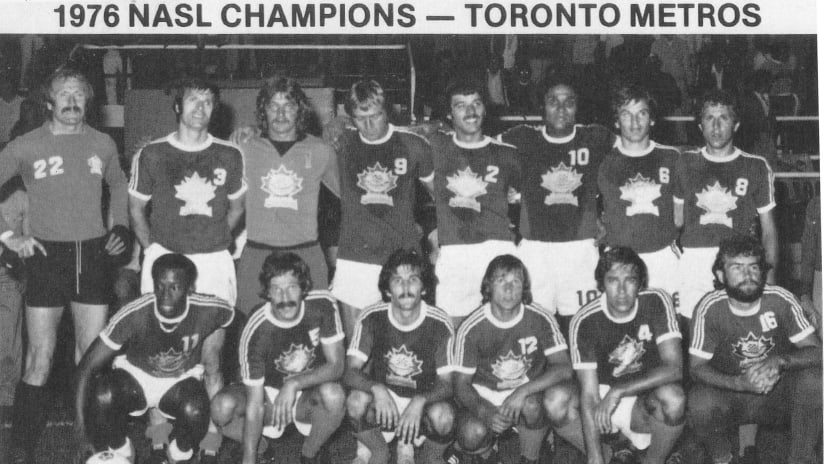On December 11th, 1970 and an announcement was made regarding the addition of two teams to the NASL. One was the New York Cosmos, the other the Toronto Metros.
John Fisher, a Canadian publicist, headed a group of businessmen determined to bring soccer back to the Big Smoke and proceeded on another whirlwind tour of signing players from all across the world to make it happen. Some of the bigger stars they brought on board included Dick Howard, who went on to appear in net for Canada, as well as provide the face of soccer coverage in Canada for nearly three decades. Joining him in both endeavours was the late Graham Leggat, a Scottish player of some renown who took on coaching and playing roles in the first season for the Metros before settling into the host's chair on Soccer Saturday.
Metros opened their first season on the road with a 2-2 tie in Dallas. Their first game in the cosy environs of Varsity Stadium came on May 15th and saw them draw 2-2 with the other team announced only six months ago, the Cosmos. Their first season didn't go to plan, as the new team won only 5 games all season (one more than the similarly fresh-faced Montreal Olympique!) and ended up third in their division. The Metros sputtered along for three more seasons until after the 1974 season when they underwent an ownership change.
Toronto Croatia has claims to being founded in 1956, and had played in the National Soccer League, enjoying a good deal of success in the early 70's. Croatia were looking to expand and buy their way to the top table and Metros were looking to sell their floundering franchise. The NASL was just happy to have someone solvent operating the team, even if the overt ethnicity of the new team name, Toronto Metros-Croatia, made them balk.
Their first season, in 1975, saw them make it to the playoffs but get knocked out by eventual Soccer Bowl winners, Tampa Bay. The following season saw some changes, with Robert Iarusci and Carmine Marcantonio coming in as rookies and two of the best signings were the retention of Gene Strenicer and the Brazilian Ivair Ferreira in midfield. The name that was on everyone's lips on opening day, however, was the winner of the 1965 Balon D'Or, Eusebio. Acquired from the slowly sinking Boston Minutemen, a Eusebio on one and a half legs was still a real threat in the NASL at that time. Trainer Pat Quinn kept him in decent enough shape for the Black Pearl of Mozambique to glide across the turf and score 16 goals. He would lay on assists for four more over the course of his 21 games.
Eusebio's arrival didn't immediately guarantee success for the Toronto club. Despite a strong start they still struggled to fill Varsity, with average attendance over the season being reported as only 5,555. This led to some unexpected cash flow problems, which in turn led to some unusual fund raising techniques.
Filip Blaskovic had turned out for Dinamo Zagreb over 200 times but was now in Toronto, wanting to play but also needing to be paid. The local Croatian community rallied around the club, and a collection plate was passed around after the services at Our Lady Queen of Croatia. Blaskovic was paid and went on to play for Metros- Croatia for a further two seasons. Further travails awaited in the form of a mid-season slump that saw the team go seven games without scoring and Eusebio embroiled in a quarrel with the dictatorial coach Ivan Markovic.
A decision had to be made; the star player that could blow apart defenses with ease, or the coach that kept him on an altogether too short leash. The coach from the previous season was re-hired and, along with the acquisition of Wolfgang Sunholz, Metros-Croatia played their way to second in their division and a spot in the playoffs. A first round playoff against local rivals Rochester Lancers saw Toronto skip through to the next round after a late (late!) goal from Gene Strenicer. A tense shootout win over Chicago Sting led to a semi-final against a strong Tampa Bay Rowdies. Eusebio led the way, as ever, and a 2-0 victory followed. The 28th of August saw Toronto head to Seattle and take on Minnesota Kicks at the Kingdome.
League officials were so incensed by the procession of a team so brazenly ethnic that they instructed the announcers on the television feed to only refer to the teams by their city names. 25,765 joined them there and saw Eusebio hammer home a direct free kick towards the end of the first half. Ivair would feed Lukacevic for the second and bundle home a rebound for the third and final goal. Toronto Metros-Croatia were champions of the NASL and as Eusebio hoisted the trophy into the sultry Seattle air, one church basement at Bloor and Dufferin was a little rowdier than most.
Metros-Croatia would continue on for two more years before being sold to Global Television. The team was renamed Toronto Blizzard in an attempt to have them identify with a wider Canadian audience. Their tenure did not get off to an auspicious start. Their first game at the new Exhibition Stadium played host to the Fort Lauderdale Strikers and a snow storm. A 2-1 defeat didn't do much to lighten the mood, but the Blizzard went on to enjoy some success in later seasons. Roberto Bettega would join the team form Juventus for the 1983 season and, along with Canadian captain Bruce Wilson and South African legend Ace Ntsoelengoe, drive the team on to two consecutive Soccer Bowl Finals in '83 and '84. The NASL would collapse after the 1984 season, but the Blizzard would continue to survive on their own, moving to the venerable National Soccer League for a season before signing on as a charter member of the new Canadian Soccer League.

